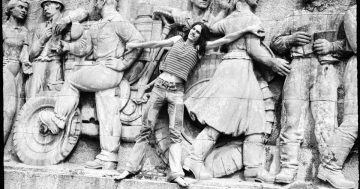The exhibition From Nothing to One centres on the position, movement, vision of the photographer as a young person, as well as his travalled path seen as representing his life story. His story is about breaking free from limitations; about losing one’s freedom and fighting for self-liberation. The photographic and cinematic traces of this struggle are exhibited in the form of an intermedial installation. In the showcased photofilms, Gusztáv Hámos’s identity formation, his numerous (self-)quotations and early photographs taken in Budapest, are linked to the historical, collective perspective and the history of Budapest’s Liberty Square.
From the artist’s Cities series, the photo films entitled From Point to Line and From Surface to Space (2012–2019) – each presented in separate screenings – offer “walk throughs” of non-existent cities bearing fictitious names, thereby telling the story of the inhabitants’ relationship to the powers that be – to dominance, freedom, police surveillance, dictatorship, war and personal disaster, as well as to “where we stand”. The Cities series is inspired by Italo Calvino’s 1972 novel Invisible Cities. The images and narration are accompanied by a singing voice, while the melody of each city is created by its own unique world of noise. As a special feature, the exhibition also showcases a number of photographs from the 1970s, which have never been seen in Hungary before, or if they have, it was over quarter of a century ago.
These conceptual photographs and photo performances are centred on self-thematisation, which – together with the photofilms and photo objects – maps out in the exhibition the spatial trajectory of the subject, i.e. the interweaving of individual and collective stories and perceptions, and the formation of individual identities. In Seins Fiction (1980), a two-channel video installation on crossing physical and biographical boundaries, we hear a quote from Frigyes Karinthy’s Heavenly Report, from which the title of the exhibition was borrowed: “They also call me responsibility. (…) Who am I then? (…) The smallest movement, a starting point, the first infinitesimal segment of the road that leads from Nothing to One.” With a series of photographs, photo tableaux and photo objects created between 1974 and 1924, the exhibition traces in a reconstructive manner the limits of individual freedom under a totalitarian regime.
From Nothing to One is the first large-scale solo exhibition in Hungary of the artist duo Gusztáv Hámos and Katja Pratschke. Gusztáv Hámos left Hungary in 1979 and settled in West Berlin, where he has been working jointly with Katja Pratschke since 1993. Their main genre is photofilm, largely consisting of still photographic images. In their own words, by photofilm “we understand films that essentially consists of photographs. Photographs placed in a cinematic context create filmic experience. In photofilms, the film medium is dissected into its components. Photofilm authors experiment with the relationship of text, sound and image, refelecting on the composition of the cinematographic. They let us “think” cinema.”
Acoustic and textual elements constitute an important component of these photofilms. The narration composed of quotations and inspirations drawn from works of fiction as well as the artists’ own texts, along with the musical pieces composed specifically for the film (also containing musical quotations and effects), simultaneously guide the perception of the viewers-listeners. In this way, an inner sense of the given subject matter can indeed emerge in the viewers themselves, resulting from the unity of the image, text and music. The artist duo’s practice, which is founded on the relationship between technical images, photography and film, is implemented not only through interactive and installative image-making (tableaux, photo sequences, three-dimensional photo objects, and photofilms), but also through such theoretical activities as organising exhibitions and symposia and compiling publications.
